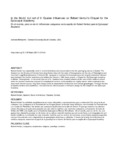Mostrar el registro sencillo del ítem
En el mundo, pero no de él: influencias cuáqueras en la capilla de Robert Venturi para la Episcopal Academy
| dc.contributor.author | Mihalache, Andreea | |
| dc.date.accessioned | 2019-05-31T08:26:55Z | |
| dc.date.available | 2019-05-31T08:26:55Z | |
| dc.date.issued | 2017 | |
| dc.identifier.citation | Mihalache, A. (2018). En el mundo, pero no de él. Actas De Arquitectura Religiosa Contemporánea, 5, 86-101. https://doi.org/10.17979/aarc.2017.5.0.5144 | es_ES |
| dc.identifier.issn | 2340-5503 | |
| dc.identifier.uri | http://hdl.handle.net/2183/23101 | |
| dc.description.abstract | [Resumen] Robert Venturi ha señalado repetidamente en varias entrevistas y conversaciones que su educación fue como la de un cuáquero. Los cuáqueros (o la Sociedad de los Amigos) tienen profundos lazos históricos con el estado de Pennsylvania y la ciudad de Filadelfia y han tenido una presencia significativa en la vida de Venturi. Propongo examinar las intersecciones discretas y en gran parte pasadas por alto entre la estética y las creencias cuáqueras y el proyecto de tesis de Venturi de 1950, una capilla para la Academia Episcopal en Merion, Pensilvania. «En el mundo, pero no de él», los cuáqueros han situado la paradoja en el núcleo de su cultura material: mientras que al mundo físico se le despojaba de contenido metafísico, la artesanía era muy valorada; mientras que los centros de reuniones nunca fueron espacios sagrados, siempre han actuado como depositarios de genealogías históricas y culturales. A través de la lente de la doctrina y la estética cuáquera, examinaré el papel de la paradoja en el diseño de Venturi para la capilla de la Episcopal Academy. | es_ES |
| dc.description.abstract | [Abstract] Robert Venturi has repeatedly noted in several interviews and conversations that his upbringing was as a Quaker. The Quakers (or the Society of Friends) have deep historic ties with the state of Pennsylvania and the city of Philadelphia and have had a significant presence in Venturi’s life. I propose to examine the inconspicuous and largely overlooked intersections between the Quaker aesthetics and beliefs and Venturi’s 1950 thesis project, a Chapel for the Episcopal Academy in Merion, Pennsylvania. «In the world, but not of it», Quakers have situated paradox at the core of their material culture: while the physical world was stripped of metaphysical content, craftsmanship was highly valued; while meetinghouses were never sacred spaces, they have always acted as depositories of historical and cultural genealogies. Through the lens of Quaker doctrine and aesthetics, I will examine the role of paradox in Venturi’s design for the Chapel for the Episcopal Academy | es_ES |
| dc.language.iso | eng | es_ES |
| dc.publisher | Universidade da Coruña | es_ES |
| dc.relation.uri | https://doi.org/10.17979/aarc.2017.5.0.5144 | es_ES |
| dc.rights | Atribución-NoComercial 4.0 España | es_ES |
| dc.rights.uri | http://creativecommons.org/licenses/by-nc/3.0/es/ | * |
| dc.subject | Robert Venturi | es_ES |
| dc.subject | Cuáqueros | es_ES |
| dc.subject | Arquitectura religiosa | es_ES |
| dc.subject | Paradoja | es_ES |
| dc.subject | Contexto | es_ES |
| dc.subject | Quakers | es_ES |
| dc.subject | Sacred architecture | es_ES |
| dc.subject | Paradox | es_ES |
| dc.subject | Context | es_ES |
| dc.title | En el mundo, pero no de él: influencias cuáqueras en la capilla de Robert Venturi para la Episcopal Academy | es_ES |
| dc.title.alternative | In the World, but not of It: Quaker Influences on Robert Venturi’s Chapel for the Episcopal Academy | es_ES |
| dc.type | journal article | es_ES |
| dc.rights.accessRights | open access | es_ES |
| UDC.journalTitle | Actas de Arquitectura Religiosa Contemporánea | es_ES |
| UDC.volume | 5 | es_ES |
| UDC.startPage | 86 | es_ES |
| UDC.endPage | 101 | es_ES |
| UDC.coleccion | Publicacións UDC | es_ES |






